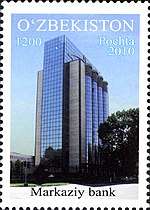Central Bank of Uzbekistan
The Central Bank of Uzbekistan, officially the Central Bank of the Republic of Uzbekistan (Uzbek: O'zbekiston Respublikasi Markaziy banki / Ўзбекистон Республикаси Марказий Банки), is the country's national bank. The current chairman of the central bank is Mamarizo Nurmuratov
 | |
| Established | 1991 |
|---|---|
| Ownership | 100% state ownership[1] |
| Governor | Mamarizo Nurmuratov |
| Central bank of | Uzbekistan |
| Currency | Uzbekistani som |
| Website | cbu |
Structure of the Central Bank
The Central Bank of the Republic of Uzbekistan represents a centralized control system. For the performance of assigned tasks it creates the appropriate services and establishments, which work on the basis of rules confirmed by the Board of the Central Bank.
The structure and bodies of management of the Central Bank are determined by the Law “On the Central Bank”. The supreme body of the Central Bank is the Board of the Central Bank. The Board consists of 11 members and is headed by the Chairman who is, at the same time, Chairman of the Central Bank. The Board of the Central Bank is allocated large powers by definition and regulation of the basic directions of monetary policy and development of the banking system.
Cooperation with international financial organizations
There is integration of the Republic of Uzbekistan and its Central Bank in the world community. The Central Bank maintains Mutual cooperation with:
- International Monetary Fund (IMF)
- World Bank
- European Bank for Reconstruction and Development
- Asian Development Bank
The international cooperation has allowed the bank to begin realization of the received credits on transformation system, maintenance of balance of payments, financing of private business, institutional and rehabilitation loans, and others.
There is a special working group, including an IMF representative, which is in charge of implementing further liberalization of the exchange market. The basic task of the working group is the creation of conditions, and development of a strategy, for maintenance of the convertibility of the Uzbek som on the current international operations.
The positive results of work with the international financial organizations opens new prospects for the realization of joint projects together with various economic institutes and large banks of the world.
Relations with other national banks
The Central bank of Uzbekistan has been active in developing good relations with other national banks. Besides operational communications, the Central Bank receives support in training the experts and consulting services from the correspondents. There are most fruitful relations with:
- Deutsche Bank
- Deutsche Bundesbank (Germany)
- UBS Banks and Credit Suisse (Switzerland)
- Bank of England
- Bank of France
- Bank of India
and other worldwide banks.
Exchange policy of the Central Bank
The main purpose of transition, in the transition period from planned economy to market mechanism, is stabilization and structural transformation. An ultimate goal is the improvement of economic growth, full employment, price stability and sustainability of the balance of payments.
After getting independence, Uzbekistan has faced a few difficulties about the realization of macroeconomic reforms to overcome inflationary processes and a decline in manufacturing to create adequate conditions for the financial system.
Functions of the Central Bank
"The Central Bank of the Republic of Uzbekistan is the state issuing and reserve bank. The Central Bank is authorized by the Constitution of the Republic of Uzbekistan. The Central Bank cooperates with national and Central Banks of other states on the basis of intergovernmental and interbank agreements. The Central Bank of the Republic of Uzbekistan has 14 regional branches, functioning in regions of the country."
The Central Bank is the depository of the international financial organizations. The Central Bank is accountable to the Supreme Council of the Republic of Uzbekistan and independent of the executive bodies.
The basic functions of the Central bank are development and realization of economic policy of the state in the field of money circulation, crediting, financing, accounting, exchange relations, monetary system management of the Republic of Uzbekistan.
The task of maintenance of money circulation stability and solvency of money in the territory of the republic is performed by the Central Bank by management of money turnover, regulation structure of money supply. The Central Bank issues money to circulation and conducts forecasting of money turnover.
Chairmen
- Fauzulla Mulladzhanov, 1991-2017[2]
- Mamarizo Nurmuratov, 2017-
Numismatic Collection
As part of its role in managing the monetary supply of Uzbekistan the National Bank has established a collection of coins from the region over the past two and half thousand years. The bank takes pride in its collection claiming it has "created the most valuable collection of ancient coins able to compete, if not in quantity than in quality, with the most famous numismatic collections of the world" (National Bank, 2010: 10). The collection has been published in four volumes (1997, 2000, 2000, 2001), a total of 400 coins and covers the whole history of Central Asia but with a focus on the Islamic period.
See also
- Economy of Uzbekistan
- Uzbek so'm
References
- https://d-nb.info/1138787981/34
- Pastor, Mr Gonzalo C. (April 22, 2001). "The IMF and the Ruble Area, 1991-93". International Monetary Fund – via Google Books.
- Official site: The Central Bank of the Republic of Uzbekistan (in Uzbek and Russian)
- National Bank of Uzbekistan (1997/2000/2000), Catalogue of Antique and Medieval Coins of Central Asia, 3 Vols. Tashkent
- National Bank of Uzbekistan (2001), Coins from the Collection of the National Bank of Uzbekistan Anniversary Edition, Tashkent